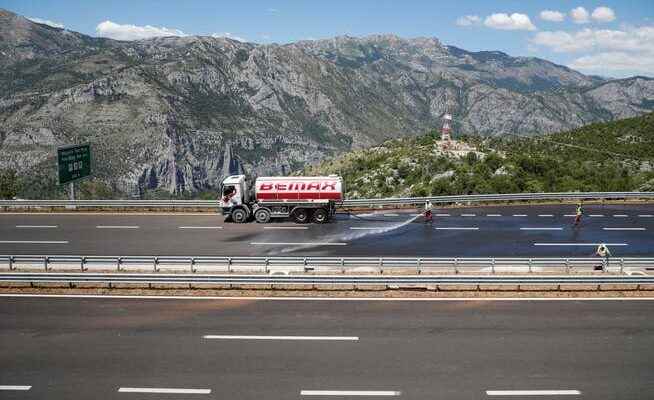After Lithuania, Estonia and Latvia have also left the Beijing-sponsored 17+1 format. The associated economic hopes have not been fulfilled.
Workers clean a section of the Chinese-built Bar-Boljare highway in Montenegro ahead of its opening in July 2022.
Estonia and Latvia left the 17+1 economic platform on Thursday, which aims to boost cooperation between Central and Eastern European countries and China. The format had already shrunk to 16+1 countries a year ago after Lithuania gave up – so it’s now 14+1.
The decisions of Tallinn and Riga were coordinated and communicated only briefly. The two governments merely state that they have decided to leave. However, we remain interested in a constructive and pragmatic relationship with China, based on international law, human rights and a rules-based international order. Beijing has not yet responded.
A year ago, Lithuania caused a much bigger stir when, by withdrawing from the format, it also initiated a rapprochement with Taiwan, which led to the establishment of a Taipei liaison office in Vilnius. Beijing responded with severe economic sanctions.
The remaining 14 countries of the format are the 9 EU members Bulgaria, Greece, Croatia, Poland, Romania, Slovenia, Slovakia, the Czech Republic and Hungary. There are also 5 Western Balkan countries.
Hopes for “Chinese recovery” disappointed
The reasons for the exit of the Baltic States are economic and political. For one, the platform has failed to meet countries’ economic expectations. However, this does not only apply to the Baltics, but to all participating countries. But the Balts take issue with China’s Russia policy more than others. Beijing has never condemned Moscow’s attack on Ukraine and, on the contrary, maintains friendly relations with Russia more than ever.
The 17+1 format was founded in Budapest in 2012 on a Chinese initiative. In the broadest sense, it is part of the Belt and Road strategy with which the Middle Kingdom wants to increase its prosperity and global influence thanks to infrastructure projects and trade relations.
China experts cite a number of motives that prompted Beijing to take the initiative at the beginning of the 2010s: the Eastern European countries had recovered more quickly than Western Europe from the shock of the financial and economic crisis after 2008. But because their level of prosperity was still well below that of Western Europe, they were receptive to the great economic power’s offer of cooperation. Finally, China also saw an opportunity to use the initiative to compete with the EU in the region and curb American influence, which is strong in many of these countries.
The 17 countries did not accept the Chinese offer out of sympathy or geopolitical intentions, but had simple economic calculations. They had little to lose and much to gain if they believed the lofty plans of the Chinese. In any case, accession had one advantage: it aroused the mistrust and attention of Brussels and Washington. And that alone could at least be capitalized on politically.
However, the disappointment was not long in coming. Hopes for large Chinese direct investments remained unfulfilled from year to year. According to the think tank Merics, China invested just under 9 billion euros between 2010 and 2019 in the 12 EU member states of the initiative. According to one observer, Beijing has invested much more political than economic capital in this platform.
Although the volume of trade with China grew in many countries, increasing imports from China were responsible for this. When members met for their most recent summit in February 2021, the atmosphere was subdued. Many Eastern Europeans only allowed themselves to be represented with the second or third diplomatic set.
Central and Eastern Europe is not a region
The heterogeneous group of countries is anything but a region. The results after ten years of cooperation with China are correspondingly different. In addition to the Baltics, who have opted out, Poland, Romania and Bulgaria are also skeptical about the benefits of the platform.
The situation is different for non-EU members in the Balkans. They are economically far behind the average of the EU countries and are looking for investments and infrastructure projects under high pressure. China is ready: a high-speed line is under construction between Belgrade and Budapest, with completion years behind schedule. A Chinese-built highway runs through the mountains of Montenegro, bringing the country to the brink of a debt crisis. Despite such difficulties, the countries of the Western Balkans are among the strongest supporters of cooperation with China.
One should not assume that after the Balts leave, there will be a mass exodus of other members of the platform. Nor is it to be expected that a new beginning and an intensification of economic relations with China will now take place. Rather, 14+1 could become an event whose stagnation illustrates China’s declining influence in Central and Eastern Europe.
